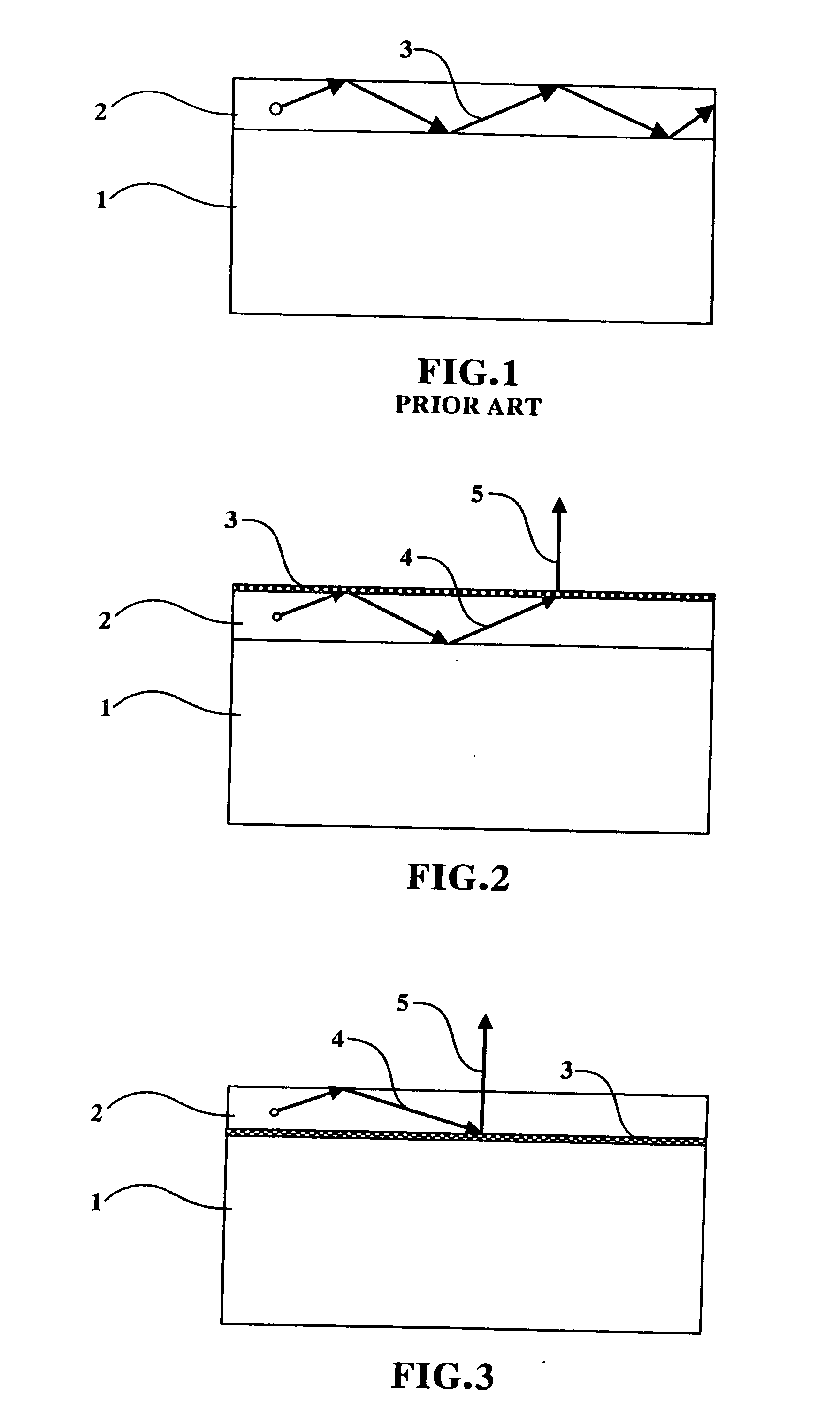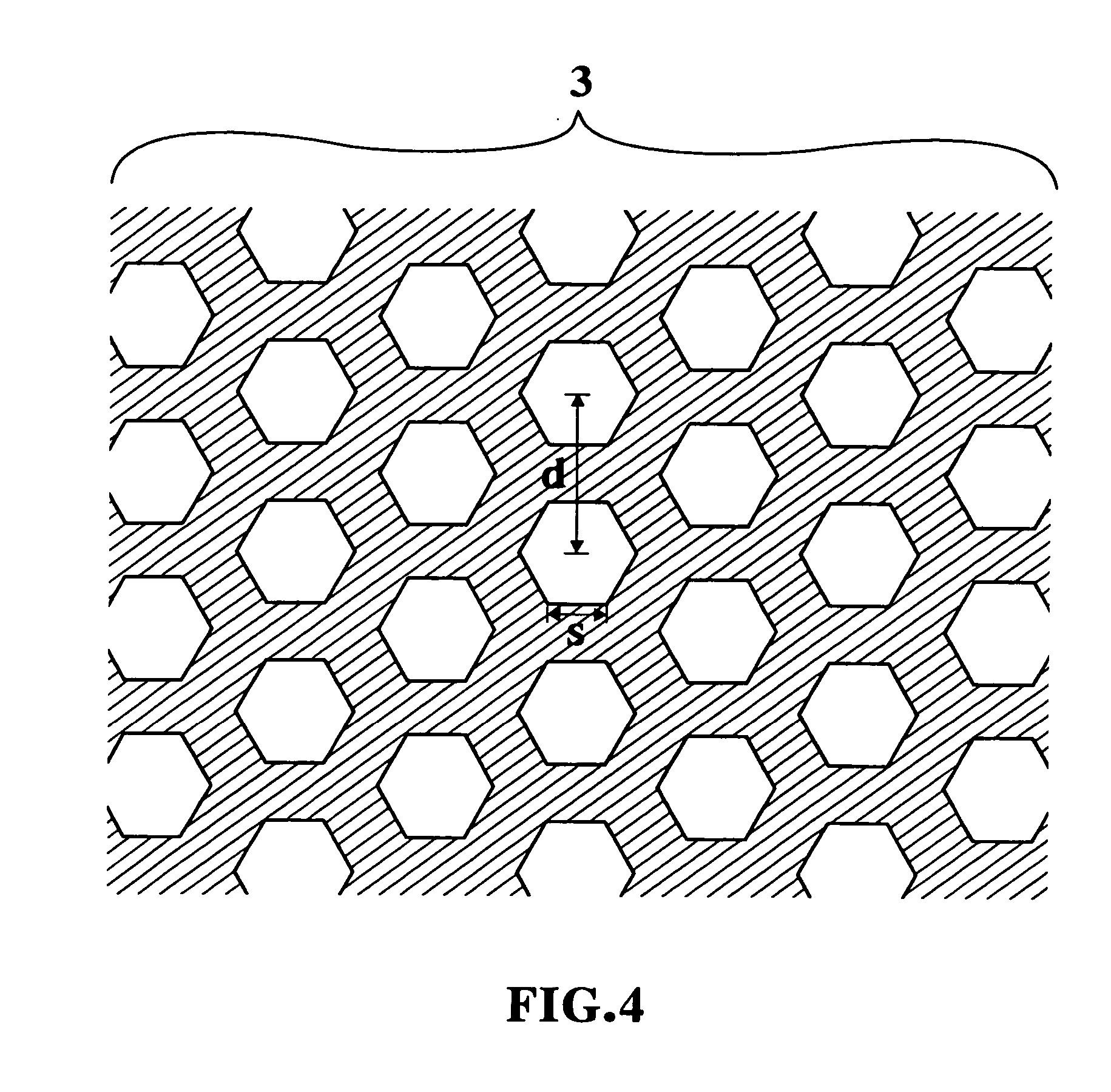Light emitting diode with diffraction lattice
a light-emitting diode and diffraction lattice technology, which is applied in the direction of basic electric elements, electrical equipment, semiconductor devices, etc., can solve the problems of low light extraction efficiency of ordinary leds, limited light extraction efficiency of led chips, and sensitive to emitted wavelengths, so as to improve light extraction efficiency and reduce the difference in the wavelength of led chips. , the effect of high efficiency
- Summary
- Abstract
- Description
- Claims
- Application Information
AI Technical Summary
Benefits of technology
Problems solved by technology
Method used
Image
Examples
example 1
[0023] The principal scheme of the LED embodied in Example 1 is shown in FIG. 2. It has a sapphire (Al.sub.2O.sub.3) substrate 1 upon which a gallium-nitride-based LED structure 2 is grown.
[0024] On the gallium-nitride-based LED structure a two-dimensional CPDL 3 is formed by dry surface etching. The light scattering by CPDL convert the laterally propagating light 4 into the vertically propagating light 5 and, thus, enhance the light extraction efficiency.
[0025] The CPDL structure is shown in FIG. 4.
[0026] The period d of the CPDL should satisfy the equation d=m.lamda. / n, where m=1, 2, 3 . . . and .lamda. is the wavelength of the light generated by LED, and n is the refraction index of GaN. To make the scattering with m=1, 2, 3 . . . most effective the zero order of diffraction with m=0 should be suppressed. This happens when height of the hexagonal islands forming CPDL is h=.lamda.(2l+1) / 2n, l=0, 1, 2, 3 . . ., and total areas of islands and trenches in CPDL are equal. To make t...
example 2
[0028] The principal scheme of the LED embodied in Example 2 is shown in FIG. 3. It has a sapphire (Al.sub.2O.sub.3) substrate 1 on which a two-dimensional CPDL 3 is formed by surface etching. On the CPDL a gallium-nitride-based LED structure 2 is grown.
[0029] The CPDL structure is shown in FIG. 5.
[0030] The light scattering by CPDL convert the laterally propagating light 4 into the vertically propagating light 5 and, thus, enhance the light extraction efficiency.
[0031] The period d of the CPDL should satisfy the equation d=m.lamda. / n, where m=1, 2, 3 . . . and .lamda. is the wavelength of the light generated by LED, and n is the refraction index of GaN. To make the scattering with m=1, 2, 3 . . . most effective the zero order of diffraction with m=0 should be suppressed. This happens when heights of the hexagonal islands forming CPDL is h=.lamda.(2l+1)2n, l=0, 1, 2, 3 . . , and total areas of islands and trenches in CPDL are equal. To make these areas equal the side s hexagon is...
example 3
[0035] The principal scheme of the LED embodied in Example 3 is shown in FIG. 2. It has a sapphire (Al.sub.2O.sub.3) substrate 1 upon which a gallium-nitride-based LED structure 2 is grown.
[0036] On the gallium-nitride-based LED structure a two-dimensional Al.sub.2O.sub.3 CPDL 3 is deposited.
[0037] The Al.sub.2O.sub.3 CPDL 3 is formed by an anodic oxidation of Al film.
[0038] The CPDL structure is shown in FIG. 6.
[0039] The period d of the CPDL should satisfy the equation d=m.lamda. / n, where m=1, 2, 3 . . . and .lamda. is the wavelength of the light generated by LED, and n is the refraction index of GaN. To make the scattering with m=1, 2, 3 . . . most effective the zero order of diffraction with m=0 should be suppressed. This happens when depths of the cylindrical holes forming CPDL is h=.lamda.(2l+1) / 2n, l is a positive integer number or zero, and their radii r satisfy the equation r=d(3 / 4.pi.).sup. 1 / 2.
[0040] For LED with .lamda.=0.5 .mu.m the parameters of the CPDL with m=1,...
PUM
 Login to View More
Login to View More Abstract
Description
Claims
Application Information
 Login to View More
Login to View More - R&D
- Intellectual Property
- Life Sciences
- Materials
- Tech Scout
- Unparalleled Data Quality
- Higher Quality Content
- 60% Fewer Hallucinations
Browse by: Latest US Patents, China's latest patents, Technical Efficacy Thesaurus, Application Domain, Technology Topic, Popular Technical Reports.
© 2025 PatSnap. All rights reserved.Legal|Privacy policy|Modern Slavery Act Transparency Statement|Sitemap|About US| Contact US: help@patsnap.com



